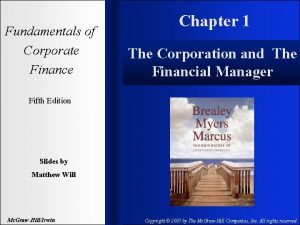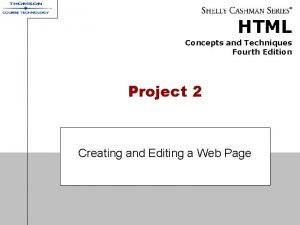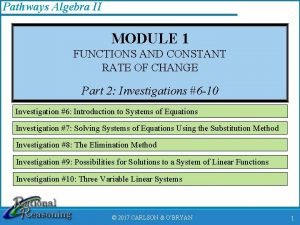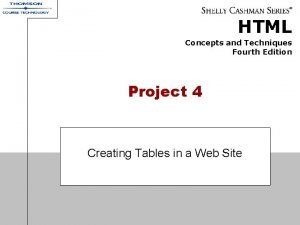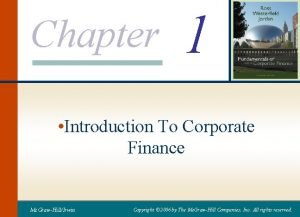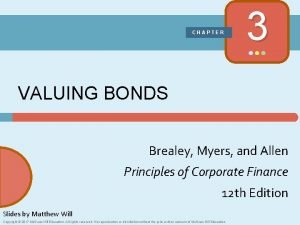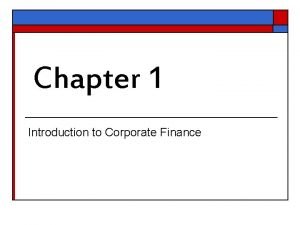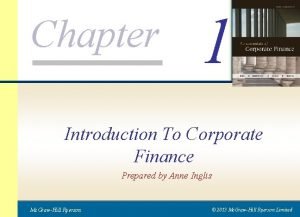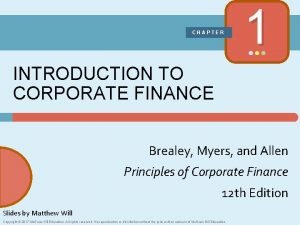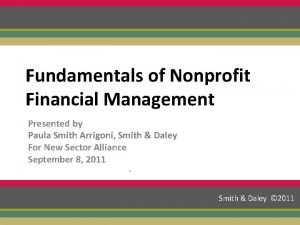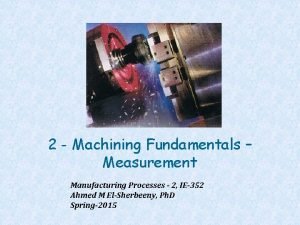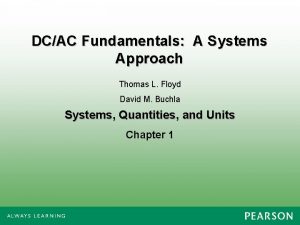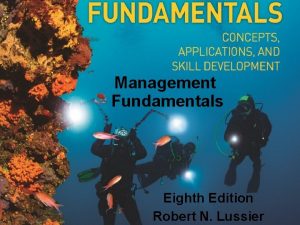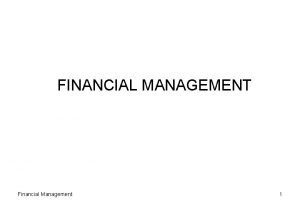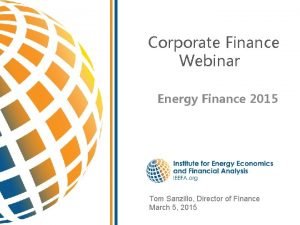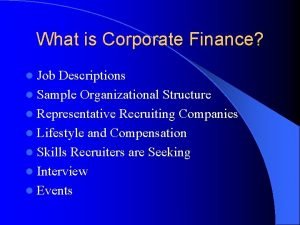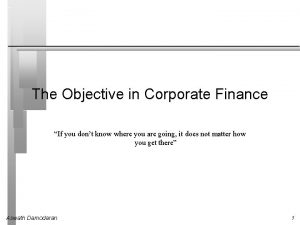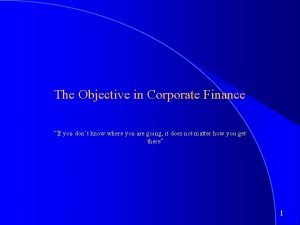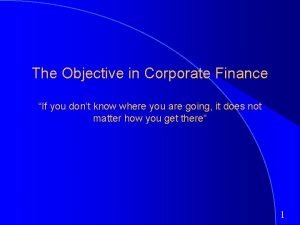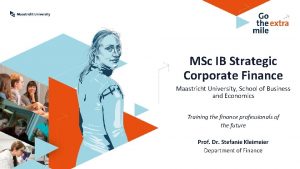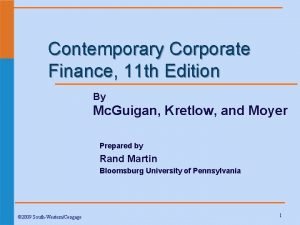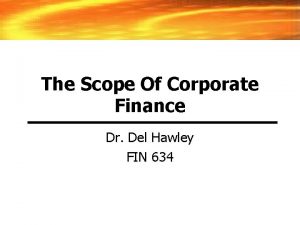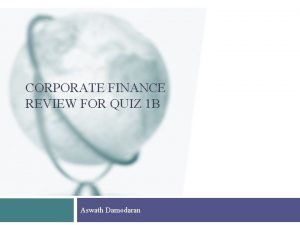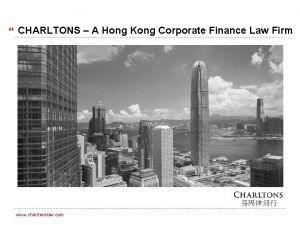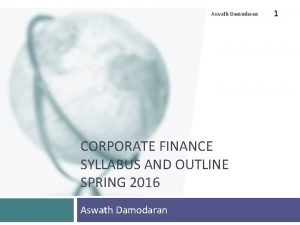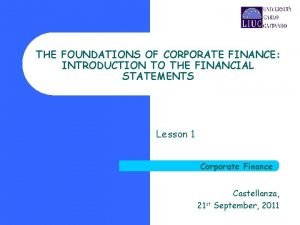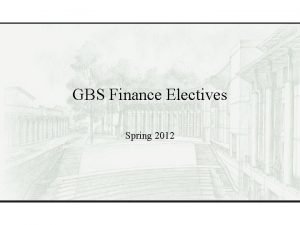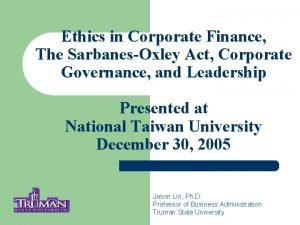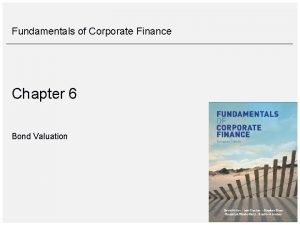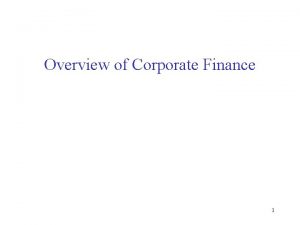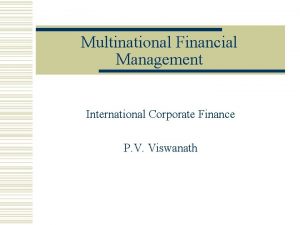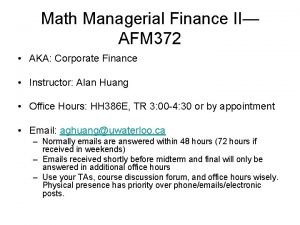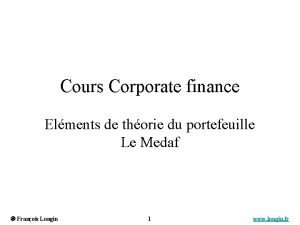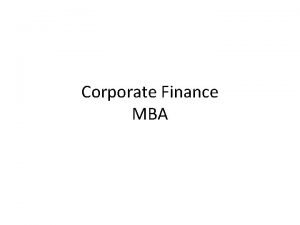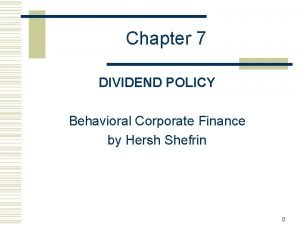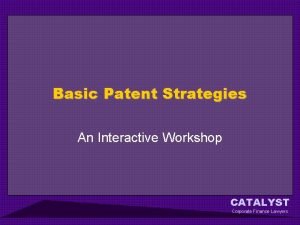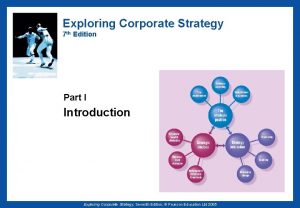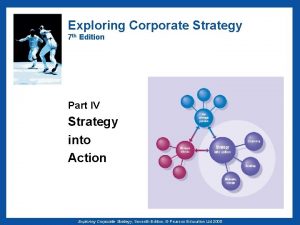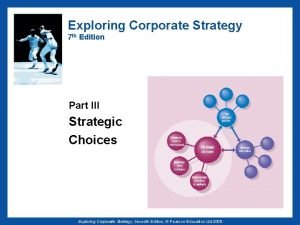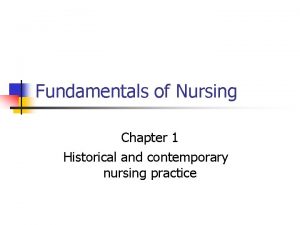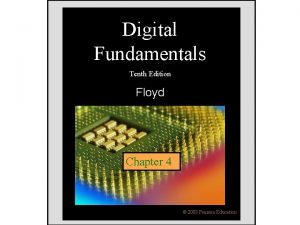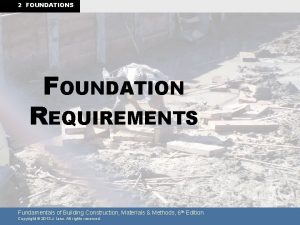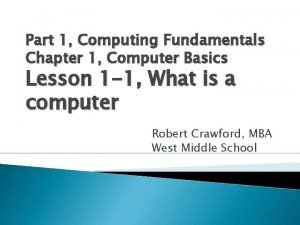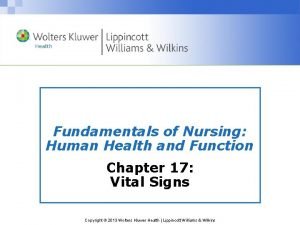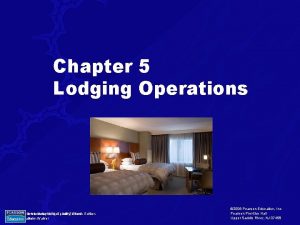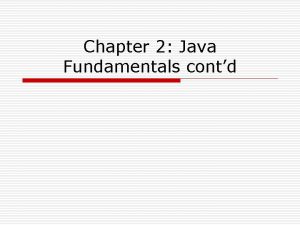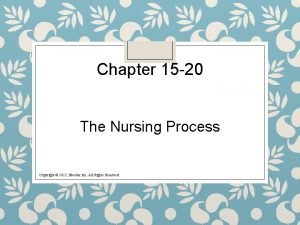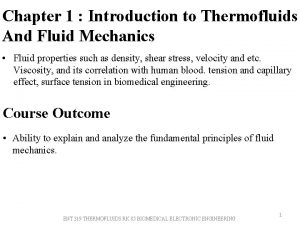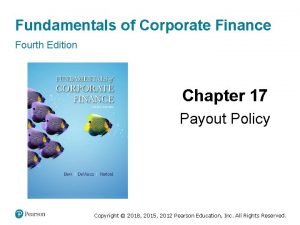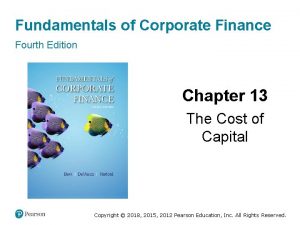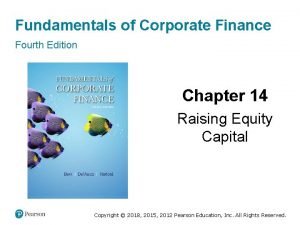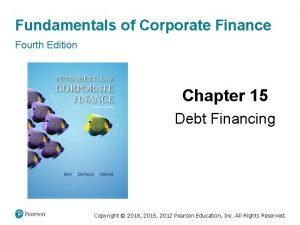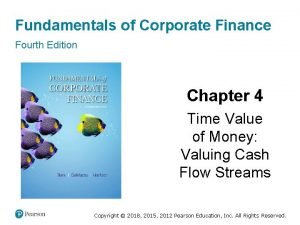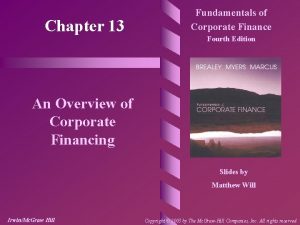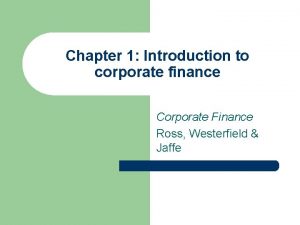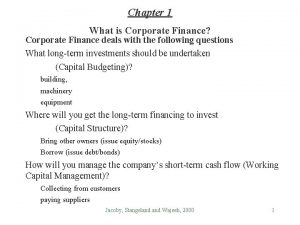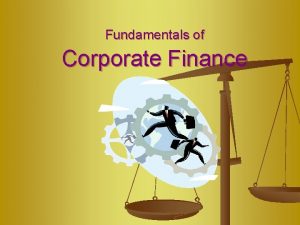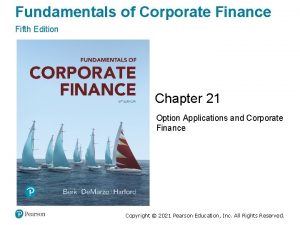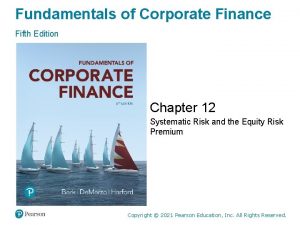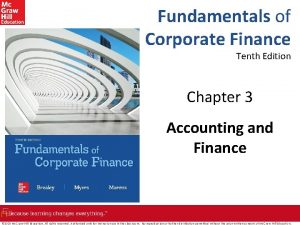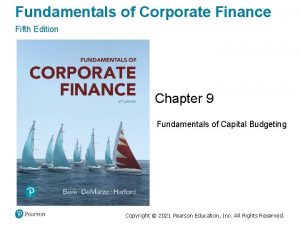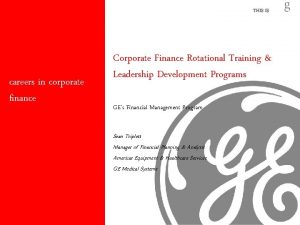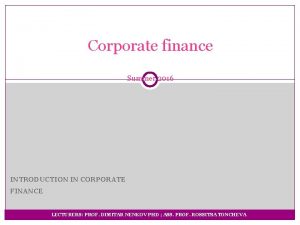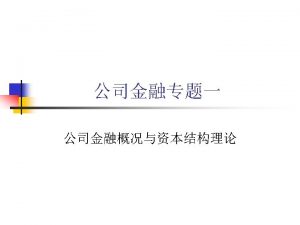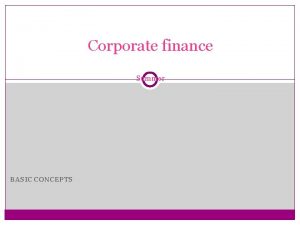Fundamentals of Corporate Finance Fourth Edition Chapter 7
































































































- Slides: 96

Fundamentals of Corporate Finance Fourth Edition Chapter 7 Stock Valuation Copyright © 2018, 2015, 2012 Pearson Education, Inc. All Rights Reserved.

Chapter Outline 7. 1 Stock Basics 7. 2 The Mechanics of Stock Trades 7. 3 The Dividend-Discount Model 7. 4 Estimating Dividends in the Dividend-Discount Model 7. 5 Limitations of the Dividend-Discount Model 7. 6 Share Repurchases and the Total Payout Model 7. 7 Putting It All Together Copyright © 2018, 2015, 2012 Pearson Education, Inc. All Rights Reserved.

Learning Objectives • Understand the tradeoff between dividends and growth in stock valuation • Appreciate the limitations of valuing a stock based on expected dividends • Value a stock as the present value of the company’s total payout • Describe the basics of common stock, preferred stock, and stock quotes • Compare how trades are executed on the NYSE and NASDAQ • Value a stock as the present value of its expected future dividends Copyright © 2018, 2015, 2012 Pearson Education, Inc. All Rights Reserved.

7. 1 Stock Basics (1 of 3) • Stock Market Reporting: Stock Quotes – Common Stock – Ticker Symbol Copyright © 2018, 2015, 2012 Pearson Education, Inc. All Rights Reserved.

Figure 7. 1 Stock Price Quote for Nike (NKE) This screenshot from Google Finance shows the basic stock price information and price history charting for the common stock of Nike. The historical price chart covers the period mid-February through late June 2013. The price of $60. 39 is for June 25, 2013. Source : www. google. com/finance? q=nke. Copyright © 2018, 2015, 2012 Pearson Education, Inc. All Rights Reserved.

7. 1 Stock Basics (2 of 3) • Common Stock – Shareholder Voting § Straight Voting § Cumulative Voting § Classes of Stock – Shareholder Rights § Annual Meeting § Proxy – Proxy Contest Copyright © 2018, 2015, 2012 Pearson Education, Inc. All Rights Reserved.

7. 1 Stock Basics (3 of 3) • Preferred Stock – Cumulative versus Non-Cumulative Preferred Stock – Preferred Stock: Equity or Debt? Copyright © 2018, 2015, 2012 Pearson Education, Inc. All Rights Reserved.

7. 2 The Mechanics of Stock Trades • Market Order • Limit Order • Round Lot • Super Display Book System • Floor Broker • Dealer Copyright © 2018, 2015, 2012 Pearson Education, Inc. All Rights Reserved.

7. 3 The Dividend-Discount Model (1 of 8) • A One Year Investor – Two potential sources of cash flows from owning a stock: § Dividends § Selling Shares Copyright © 2018, 2015, 2012 Pearson Education, Inc. All Rights Reserved.

7. 3 The Dividend-Discount Model (2 of 8) • A One Year Investor – Since the cash flows are not risk-less, they must be discounted at the equity cost of capital Copyright © 2018, 2015, 2012 Pearson Education, Inc. All Rights Reserved.

7. 3 The Dividend-Discount Model (3 of 8) • Dividend Yields, Capital Gains, and Total Returns – Dividend Yield – Capital Gain § Capital Gains Rate – Total Return Copyright © 2018, 2015, 2012 Pearson Education, Inc. All Rights Reserved.

7. 3 The Dividend-Discount Model (4 of 8) • Dividend Yields, Capital Gains, and Total Returns – The expected total return of the stock should equal the expected return of other investments available in the market with equivalent risk Copyright © 2018, 2015, 2012 Pearson Education, Inc. All Rights Reserved.

Example 7. 1 Stock Prices and Returns (1 of 4) Problem • Suppose you expect Longs Drug Stores to pay an annual dividend of $0. 56 per share in the coming year and to trade for $45. 50 per share at the end of the year. If investments with equivalent risk to Longs’ stock have an expected return of 6. 80%, what is the most you would pay today for Longs’ stock? What dividend yield and capital gain rate would you expect at this price? Copyright © 2018, 2015, 2012 Pearson Education, Inc. All Rights Reserved.

Example 7. 1 Stock Prices and Returns (2 of 4) Solution Plan • We can use Eq. 7. 1 to solve for the beginning price we would pay now (P 0) given our expectations about dividends (Div 1 = $0. 56) and future price (P 1 = $45. 50) and the return we need to expect to earn to be willing to invest (r. E = 0. 068). We can then use Eq. 7. 2 to calculate the dividend yield and capital gain rate. Copyright © 2018, 2015, 2012 Pearson Education, Inc. All Rights Reserved.

Example 7. 1 Stock Prices and Returns (3 of 4) Execute • Using Eq. 7. 1, we have Referring to Eq. 7. 2, we see that at this price, Longs’ dividend yield is The expected capital gain is $45. 50 − $43. 13 = $2. 37 per share, for a capital gain rate of Copyright © 2018, 2015, 2012 Pearson Education, Inc. All Rights Reserved.

Example 7. 1 Stock Prices and Returns (4 of 4) Evaluate • At a price of $43. 13, Longs’ expected total return is 1. 30% + 5. 50% = 6. 80%, which is equal to its equity cost of capital (the return being paid by investments with equivalent risk to Longs’). This amount is the most we would be willing to pay for Longs’ stock. If we paid more, our expected return would be less than 6. 8% and we would rather invest elsewhere. Copyright © 2018, 2015, 2012 Pearson Education, Inc. All Rights Reserved.

Example 7. 1 a Stock Prices and Returns (1 of 4) Problem: • Suppose you expect Koch Industries to pay an annual dividend of $2. 31 per share in the coming year and to trade $82. 75 per share at the end of the year. If investments with equivalent risk to Koch’s stock have an expected return of 8. 9%, what is the most you would pay today for Koch’s stock? • What dividend yield and capital gain rate would you expect at this price? Copyright © 2018, 2015, 2012 Pearson Education, Inc. All Rights Reserved.

Example 7. 1 a Stock Prices and Returns (2 of 4) Solution: Plan: • We can use Eq. 7. 1 to solve for the beginning price we would pay now (P 0) given our expectations about dividends (Div 1=$2. 31) and future price (P 1=$82. 75) and the return we need to expect to earn to be willing to invest (r. E=0. 089). • We can then use Eq. 7. 2 to calculate the dividend yield and capital gain. Copyright © 2018, 2015, 2012 Pearson Education, Inc. All Rights Reserved.

Example 7. 1 a Stock Prices and Returns (3 of 4) Execute: • Referring to Eq. 7. 2 we see that at this price, Koch’s dividend yield is The expected capital gain is $82. 75 − $78. 11 = $4. 64 per share, for a capital gain rate of Copyright © 2018, 2015, 2012 Pearson Education, Inc. All Rights Reserved.

Example 7. 1 a Stock Prices and Returns (4 of 4) Evaluate: • At a price of $78. 11, Koch’s expected total return is 2. 96% + 5. 94% = 8. 90%, which is equal to its equity cost of capital (the return being paid by investments with equivalent risk to Koch’s). This amount is the most we would be willing to pay for Koch’s stock. • If we paid more, our expected return would be less than 8. 9% and we would rather invest elsewhere. Copyright © 2018, 2015, 2012 Pearson Education, Inc. All Rights Reserved.

7. 3 The Dividend-Discount Model (5 of 8) • A Multiyear Investor – Suppose we planned to hold the stock for two years § Then we would receive dividends in both year 1 and year 2 before selling the stock, as shown in the following timeline: Copyright © 2018, 2015, 2012 Pearson Education, Inc. All Rights Reserved.

7. 3 The Dividend-Discount Model (6 of 8) • A Multiyear Investor – The formula for the stock price for a two-year investor is the same as that for a sequence of two one-year investments Copyright © 2018, 2015, 2012 Pearson Education, Inc. All Rights Reserved.

7. 3 The Dividend-Discount Model (7 of 8) • Dividend-Discount Model Equation – The price of the stock is equal to the present value of all of the expected future dividends it will pay, along with the cash flow from the sale in year N Copyright © 2018, 2015, 2012 Pearson Education, Inc. All Rights Reserved.

7. 3 The Dividend-Discount Model (8 of 8) • Dividend-Discount Model Equation – Alternatively, rather than having a stopping point where we sell the shares, we can rewrite the equation to show that the dividends go on into the future Copyright © 2018, 2015, 2012 Pearson Education, Inc. All Rights Reserved.

7. 4 Estimating Dividends in the Dividend-Discount Model (1 of 7) • Constant Dividend Growth – Assumes that dividends will grow at a constant rate, g, forever – The value of the firm depends on the dividend level of next year, divided by the equity cost of capital adjusted by the growth rate Copyright © 2018, 2015, 2012 Pearson Education, Inc. All Rights Reserved.

Example 7. 2 Valuing a Firm with Constant Dividend Growth (1 of 4) Problem • Consolidated Edison, Inc. (Con Ed) is a regulated utility company that services the New York City area. Suppose Con Ed plans to pay $2. 30 per share in dividends in the coming year. If its equity cost of capital is 7% and dividends are expected to grow by 2% per year in the future, estimate the value of Con Ed’s stock. Copyright © 2018, 2015, 2012 Pearson Education, Inc. All Rights Reserved.

Example 7. 2 Valuing a Firm with Constant Dividend Growth (2 of 4) Solution Plan • Because the dividends are expected to grow perpetually at a constant rate, we can use Eq. 7. 6 to value Con Ed. The next dividend (Div 1) is expected to be $2. 30, the growth rate (g) is 2%, and the equity cost of capital (r. E) is 7%. Copyright © 2018, 2015, 2012 Pearson Education, Inc. All Rights Reserved.

Example 7. 2 Valuing a Firm with Constant Dividend Growth (3 of 4) Execute Copyright © 2018, 2015, 2012 Pearson Education, Inc. All Rights Reserved.

Example 7. 2 Valuing a Firm with Constant Dividend Growth (4 of 4) Evaluate • You would be willing to pay 20 times this year’s dividend of $2. 30 to own Con Ed stock because you are buying a claim to this year’s dividend and to an infinite growing series of future dividends. Copyright © 2018, 2015, 2012 Pearson Education, Inc. All Rights Reserved.

Example 7. 2 a Valuing a Firm with Constant Dividend Growth (1 of 4) Problem: • Suppose Target Corporation plans to pay $0. 68 per share in dividends in the coming year. • If its equity cost of capital is 10% and dividends are expected to grow by 8. 4% per year in the future, estimate the value of Target’s stock. Copyright © 2018, 2015, 2012 Pearson Education, Inc. All Rights Reserved.

Example 7. 2 a Valuing a Firm with Constant Dividend Growth (2 of 4) Solution: Plan: • Because the dividends are expected to grow perpetually at a constant rate, we can use Eq. 7. 6 to value Target. The next dividend (Div 1) is expected to be $0. 68, the growth rate (g) is 8. 4% and the equity cost of capital (r. E) is 10%. Copyright © 2018, 2015, 2012 Pearson Education, Inc. All Rights Reserved.

Example 7. 2 a Valuing a Firm with Constant Dividend Growth (3 of 4) Execute: Copyright © 2018, 2015, 2012 Pearson Education, Inc. All Rights Reserved.

Example 7. 2 a Valuing a Firm with Constant Dividend Growth (4 of 4) Evaluate: • You would be willing to pay 62. 5 times this year’s dividend of $0. 68 to own Target stock because you are buying claim to this year’s dividend and to an infinite growing series of future dividends. Copyright © 2018, 2015, 2012 Pearson Education, Inc. All Rights Reserved.

7. 4 Estimating Dividends in the Dividend-Discount Model (2 of 7) • Dividends Versus Investment and Growth – A Simple Model of Growth § The dividend each year is equal to the firm’s earnings per share (EPS) multiplied by its dividend payout rate Copyright © 2018, 2015, 2012 Pearson Education, Inc. All Rights Reserved.

7. 4 Estimating Dividends in the Dividend-Discount Model (3 of 7) • Dividends Versus Investment and Growth – A Simple Model of Growth § The firm can increase its dividend in three ways: 1. It can increase its earnings 2. It can increase its dividend payout rate 3. It can decrease its number of shares outstanding Copyright © 2018, 2015, 2012 Pearson Education, Inc. All Rights Reserved.

7. 4 Estimating Dividends in the Dividend-Discount Model (4 of 7) • Dividends Versus Investment and Growth – A Simple Model of Growth § If all increases in future earnings result exclusively from new investment made with retained earnings, then: Copyright © 2018, 2015, 2012 Pearson Education, Inc. All Rights Reserved.

7. 4 Estimating Dividends in the Dividend-Discount Model (5 of 7) • Dividends Versus Investment and Growth – A Simple Model of Growth § New investment equals the firm’s earnings multiplied by its retention rate, or the fraction of current earnings that the firm retains: Copyright © 2018, 2015, 2012 Pearson Education, Inc. All Rights Reserved.

7. 4 Estimating Dividends in the Dividend-Discount Model (6 of 7) • Dividends Versus Investment and Growth – A Simple Model of Growth § Substituting Eq. 7. 10 into Eq. 7. 9 and dividing by earnings gives an expression for the growth rate of earnings: Copyright © 2018, 2015, 2012 Pearson Education, Inc. All Rights Reserved.

7. 4 Estimating Dividends in the Dividend-Discount Model (7 of 7) • Dividends Versus Investment and Growth – A Simple Model of Growth § If the firm chooses to keep its dividend payout rate constant, then the growth in its dividends will equal the growth in its earnings: Copyright © 2018, 2015, 2012 Pearson Education, Inc. All Rights Reserved.

Example 7. 3 Cutting Dividends for Profitable Growth (1 of 5) Problem • Crane Sporting Goods expects to have earnings per share of $6 in the coming year. Rather than reinvest these earnings and grow, the firm plans to pay out all of its earnings as a dividend. With these expectations of no growth, Crane’s current share price is $60. Suppose Crane could cut its dividend payout rate to 75% for the foreseeable future and use the retained earnings to open new stores. The return on its investment in these stores is expected to be 12%. If we assume that the risk of these new investments is the same as the risk of its existing investments, then the firm’s equity cost of capital is unchanged. What effect would this new policy have on Crane’s stock price? Copyright © 2018, 2015, 2012 Pearson Education, Inc. All Rights Reserved.

Example 7. 3 Cutting Dividends for Profitable Growth (2 of 5) Solution Plan • To figure out the effect of this policy on Crane’s stock price, we need to know several things. First, we need to compute its equity cost of capital. Next, we must determine Crane’s dividend and growth rate under the new policy. • Because we know that Crane currently has a growth rate of 0 (g = 0), a dividend of $6, and a price of $60, we can use Eq. 7. 7 to estimate r. E. Next, the new dividend will simply be 75% of the old dividend of $6. Finally, given a retention rate of 25% and a return on new investment of 12%, we can use Eq. 7. 12 to compute the new growth rate (g). Finally, armed with the new dividend, Crane’s equity cost of capital, and its new growth rate, we can use Eq. 7. 6 to compute the price of Crane’s shares if it institutes the new policy. Copyright © 2018, 2015, 2012 Pearson Education, Inc. All Rights Reserved.

Example 7. 3 Cutting Dividends for Profitable Growth (3 of 5) Execute • Using Eq. 7. 7 to estimate r. E , we have • In other words, to justify Crane’s stock price under its current policy, the expected return of other stocks in the market with equivalent risk must be 10%. • Next, we consider the consequences of the new policy. If Crane reduces its dividend payout rate to 75%, then from Eq. 7. 8 its dividend this coming year will fall to Div 1 = EPS 1 × 75% = $6 × 75% = $4. 50. Copyright © 2018, 2015, 2012 Pearson Education, Inc. All Rights Reserved.

Example 7. 3 Cutting Dividends for Profitable Growth (4 of 5) • At the same time, because the firm will now retain 25% of its earnings to invest in new stores, from Eq. 7. 12 its growth rate will increase to • Assuming Crane can continue to grow at this rate, we can compute its share price under the new policy using the constant dividend growth model of Eq. 7. 6: Copyright © 2018, 2015, 2012 Pearson Education, Inc. All Rights Reserved.

Example 7. 3 Cutting Dividends for Profitable Growth (5 of 5) Evaluate • Crane’s share price should rise from $60 to $64. 29 if the company cuts its dividend in order to increase its investment and growth. By using its earnings to invest in projects that offer a rate of return (12%) greater than its equity cost of capital (10%), Crane has created value for its shareholders. Copyright © 2018, 2015, 2012 Pearson Education, Inc. All Rights Reserved.

Example 7. 3 a Cutting Dividends for Profitable Growth (1 of 8) Problem: • Lengefeld Manufacturing expects to have earnings per share of $1. 80 in the coming year. Rather than reinvest these earnings and grow, the firm plans to pay out all of its earnings as a dividend. With these expectations of no growth, Lengefeld’s current share price is $24. Copyright © 2018, 2015, 2012 Pearson Education, Inc. All Rights Reserved.

Example 7. 3 a Cutting Dividends for Profitable Growth (2 of 8) Problem: • Suppose Lengefeld could cut its dividend payout rate to 50% for the foreseeable future and use the retained earnings to open an additional factory. The return on investment in the new factory is expected to be 15%. If we assume that the risk of the new factory is the same as the risk of its existing factories, then the firm’s equity cost of capital is unchanged. • What effect would this new policy have on Lengefeld’s stock price? Copyright © 2018, 2015, 2012 Pearson Education, Inc. All Rights Reserved.

Example 7. 3 a Cutting Dividends for Profitable Growth (3 of 8) Solution: Plan: • To figure out the effect of this policy on Lengefeld’s stock price, we need to know several things. First, we need to compute its equity cost of capital. Next we must determine Lengefeld’s dividend and growth rate under the new policy. • Because we know that Lengefeld currently has a growth rate of 0 (g = 0), a dividend of $2. 00 and a price of $24, we can use Eq. 7. 7 to estimate r. E. Copyright © 2018, 2015, 2012 Pearson Education, Inc. All Rights Reserved.

Example 7. 3 a Cutting Dividends for Profitable Growth (4 of 8) Plan (cont'd): • Next, the new dividend will simply be 50% of the old dividend of $2. 00. Finally, given a retention rate of 50% and a return on new investment of 15%, we can use Eq. 7. 12 to compute the new growth rate (g). Finally, armed with the new dividend, Lengefeld’s equity cost of capital, and its new growth rate, we can use Eq. 7. 6 to compute the price of Lengefeld’s shares if it institutes the new policy. Copyright © 2018, 2015, 2012 Pearson Education, Inc. All Rights Reserved.

Example 7. 3 a Cutting Dividends for Profitable Growth (5 of 8) Execute: • Using Eq. 7. 7 to estimate r. E we have • In other words, to justify Lengefeld’s stock price under its current policy, the expected return of other stocks in the market with equivalent risk must be 8. 33%. Copyright © 2018, 2015, 2012 Pearson Education, Inc. All Rights Reserved.

Example 7. 3 a Cutting Dividends for Profitable Growth (6 of 8) Execute: • Next, we consider the consequences of the new policy. If Lengefeld reduces its dividend payout rate to 50%, then from Eq. 7. 8 its dividend this coming year will fall to Div 1 = EPS 1 × 50% = $2. 00 × 50% = $1. 0. • At the same time, because the firm will now retain 50% of its earnings to invest in new stores, from Eq. 7. 12 its growth rate will increase to: Copyright © 2018, 2015, 2012 Pearson Education, Inc. All Rights Reserved.

Example 7. 3 a Cutting Dividends for Profitable Growth (7 of 8) Execute: • Assuming Lengefeld can continue to grow at this rate, we can compute its share price under the new policy using the constant dividend growth model of Eq. 7. 6 Copyright © 2018, 2015, 2012 Pearson Education, Inc. All Rights Reserved.

Example 7. 3 a Cutting Dividends for Profitable Growth (8 of 8) Evaluate: • Lengefeld’s share price should rise from $24 to $120. 48 if the company cuts its dividend in order to increase its investment and growth, implying that the investment has positive NPV. By using its earnings to invest in projects that offer a rate of return (15%) greater than its equity cost of capital (8. 33%), Lengefeld has created value for its shareholders. Copyright © 2018, 2015, 2012 Pearson Education, Inc. All Rights Reserved.

Example 7. 4 Unprofitable Growth (1 of 4) Problem • Suppose Crane Sporting Goods decides to cut its dividend payout rate to 75% to invest in new stores, as in Example 7. 3. But now suppose that the return on these new investments is 8%, rather than 12%. Given its expected earnings per share this year of $6 and its equity cost of capital of 10% (we again assume that the risk of the new investments is the same as its existing investments), what will happen to Crane’s current share price in this case? Copyright © 2018, 2015, 2012 Pearson Education, Inc. All Rights Reserved.

Example 7. 4 Unprofitable Growth (2 of 4) Solution Plan • We will follow the steps in Example 7. 3, except that in this case, we assume a return on new investments of 8% when computing the new growth rate (g) instead of 12% as in Example 7. 3. Copyright © 2018, 2015, 2012 Pearson Education, Inc. All Rights Reserved.

Example 7. 4 Unprofitable Growth (3 of 4) Execute • Just as in Example 7. 3, Crane’s dividend will fall to $6 × 0. 75 = $4. 50. Its growth rate under the new policy, given the lower return on new investment, will now be g = 0. 25 × 0. 08 = 0. 02 = 2%. The new share price is therefore Copyright © 2018, 2015, 2012 Pearson Education, Inc. All Rights Reserved.

Example 7. 4 Unprofitable Growth (4 of 4) Evaluate • Even though Crane will grow under the new policy, the return on its new investments is too low. The company’s share price will fall if it cuts its dividend to make new investments with a return of only 8%. By reinvesting its earnings at a rate (8%) that is lower than its equity cost of capital (10%), Crane has reduced shareholder value. Copyright © 2018, 2015, 2012 Pearson Education, Inc. All Rights Reserved.

Example 7. 4 a Unprofitable Growth (1 of 4) Problem: • Suppose Lengefeld Manufacturing decides to cut its dividend payout rate to 50% to invest in new stores, as in Example 7. 3 b. But now suppose that the return on these new investments is 8%, rather than 15%. • Give its expected earnings per share this year of $2 and its equity cost of capital of 8. 33% (we again assume that the risk of the new investments is the same as its existing investments), what will happen to Lengefeld’s current share price in this case? Copyright © 2018, 2015, 2012 Pearson Education, Inc. All Rights Reserved.

Example 7. 4 a Unprofitable Growth (2 of 4) Solution: Plan: • We will follow the steps in Example 7. 3 b, except that in this case, we assume a return on new investments of 8% when computing the new growth rate (g) instead of 15% as in Example 7. 3 b. Copyright © 2018, 2015, 2012 Pearson Education, Inc. All Rights Reserved.

Example 7. 4 a Unprofitable Growth (3 of 4) Execute: • Just as in Example 7. 3 b, Lengefeld’s dividend will fall to $2 × 50% = $2. 00. Its growth rate under the new policy, given the lower return on new investment, will now be g = 50% × 8% = 4%. The new share price is therefore Copyright © 2018, 2015, 2012 Pearson Education, Inc. All Rights Reserved.

Example 7. 4 a Unprofitable Growth (4 of 4) Evaluate: • Even though Lengefeld will grow under the new policy, the return on its new investments is too low. The company’s share price will fall if it cuts its dividend to make new investments with a return of only 8%. By reinvesting its earnings at a rate (8%) that is lower than its equity cost of capital (8. 33%), Lengefeld has reduced shareholder value. Copyright © 2018, 2015, 2012 Pearson Education, Inc. All Rights Reserved.

7. 4 Estimating Dividends in the Dividend-Discount Model (1 of 2) • Changing Growth Rates – If the firm is expected to grow at a long-term rate g after year N + 1, then from the constant dividend growth model: Copyright © 2018, 2015, 2012 Pearson Education, Inc. All Rights Reserved.

Example 7. 5 Valuing a Firm with Two Different Growth Rates (1 of 6) Problem • Small Fry, Inc. , has just invented a potato chip that looks and tastes like a french fry. Given the phenomenal market response to this product, Small Fry is reinvesting all of its earnings to expand its operations. Earnings were $2 per share this past year and are expected to grow at a rate of 20% per year until the end of year 4. At that point, other companies are likely to bring out competing products. Analysts project that at the end of year 4, Small Fry will cut its investment and begin paying 60% of its earnings as dividends. Its growth will also slow to a long-run rate of 4%. If Small Fry’s equity cost of capital is 8%, what is the value of a share today? Copyright © 2018, 2015, 2012 Pearson Education, Inc. All Rights Reserved.

Example 7. 5 Valuing a Firm with Two Different Growth Rates (2 of 6) Solution Plan • We can use Small Fry’s projected earnings growth rate and payout rate to forecast its future earnings and dividends. After year 4, Small Fry’s dividends will grow at a constant 4%, so we can use the constant dividend growth model (Eq. 7. 13) to value all dividends after that point. Finally, we can pull everything together with the dividend-discount model (Eq. 7. 4). Copyright © 2018, 2015, 2012 Pearson Education, Inc. All Rights Reserved.

Example 7. 5 Valuing a Firm with Two Different Growth Rates (3 of 6) Execute The following spreadsheet projects Small Fry’s earnings and dividends: Copyright © 2018, 2015, 2012 Pearson Education, Inc. All Rights Reserved.

Example 7. 5 Valuing a Firm with Two Different Growth Rates (4 of 6) Starting from $2. 00 in year 0, EPS grows by 20% per year until year 4, after which growth slows to 4%. Small Fry’s dividend payout rate is zero until year 4, when competition reduces its investment opportunities and its payout rate rises to 60%. Multiplying EPS by the dividend payout ratio, we project Small Fry’s future dividends in line 4. After year 4, Small Fry’s dividends will grow at the constant expected long-run rate of 4% per year. Thus, we can use the constant dividend growth model to project Small Fry’s share price at the end of year 3. Given its equity cost of capital of 8%, Copyright © 2018, 2015, 2012 Pearson Education, Inc. All Rights Reserved.

Example 7. 5 Valuing a Firm with Two Different Growth Rates (5 of 6) We then apply the dividend-discount model (Eq. 7. 4) with this terminal value: Copyright © 2018, 2015, 2012 Pearson Education, Inc. All Rights Reserved.

Example 7. 5 Valuing a Firm with Two Different Growth Rates (6 of 6) Evaluate • The dividend-discount model is flexible enough to handle any forecasted pattern of dividends. Here, the dividends were zero for several years and then settled into a constant growth rate, allowing us to use the constant dividend growth model as a shortcut. Copyright © 2018, 2015, 2012 Pearson Education, Inc. All Rights Reserved.

Example 7. 5 a Valuing a Firm with Two Different Growth Rates (1 of 8) Problem: • Annie-Bell, Inc. , has just invented hotdog/taco combo. Given the phenomenal market response to this product, Annie-Bell is reinvesting all of its earnings to expand its operations. • Earnings were $5 per share this past year and are expected to grow at a rate of 30% per year until the end of year 3. At that point, other companies are likely to bring out competing products. Copyright © 2018, 2015, 2012 Pearson Education, Inc. All Rights Reserved.

Example 7. 5 a Valuing a Firm with Two Different Growth Rates (2 of 8) Problem: • Analysts project that at the end of year 3, Annie-Bell will cut its investment and begin paying 75% of its earnings as dividends. Its growth will also slow to a long-run rate of 5%. • If Annie-Bell’s equity cost of capital is 9%, what is the value of a share today? Copyright © 2018, 2015, 2012 Pearson Education, Inc. All Rights Reserved.

Example 7. 5 a Valuing a Firm with Two Different Growth Rates (3 of 8) Solution: Plan: • We can use Annie-Bell’s projected earnings growth rate and payout rate to forecast its future earnings and dividends. After year 3, Annie-Bell’s dividends will grow at a constant 5%, so we can use the constant dividend growth model (Eq. 7. 13) to value all dividends after that point. Finally, we can pull everything together with the dividend-discount model (Eq. 7. 4). Copyright © 2018, 2015, 2012 Pearson Education, Inc. All Rights Reserved.

Example 7. 5 a Valuing a Firm with Two Different Growth Rates (4 of 8) Execute: • The following spreadsheet projects Annie-Bell’s earnings and dividends: Copyright © 2018, 2015, 2012 Pearson Education, Inc. All Rights Reserved.

Example 7. 5 a Valuing a Firm with Two Different Growth Rates (5 of 8) Execute: • Starting from $5. 00 in year 0, EPS grows by 30% per year until year 3, after which growth slows to 5%. Annie-Bell’s dividend payout rate is zero until year 3, when competition reduces its investment opportunities and its payout rate rises to 75%. Multiplying EPS by the dividend payout ratio, we project Annie-Bell’s future dividends. Copyright © 2018, 2015, 2012 Pearson Education, Inc. All Rights Reserved.

Example 7. 5 a Valuing a Firm with Two Different Growth Rates (6 of 8) Execute: • From year 3 onward, Annie-Bell’s dividends will grow at the expected long-run rate of 5% per year. Thus we can use the constant dividend growth model to project Annie-Bell’s share price at the end of year 3. Given its equity cost of capital of 9%, Copyright © 2018, 2015, 2012 Pearson Education, Inc. All Rights Reserved.

Example 7. 5 a Valuing a Firm with Two Different Growth Rates (7 of 8) Execute: • We then apply the dividend discount model (Eq. 7. 4) with this terminal value: Copyright © 2018, 2015, 2012 Pearson Education, Inc. All Rights Reserved.

Example 7. 5 a Valuing a Firm with Two Different Growth Rates (8 of 8) Evaluate: • The dividend-discount model is flexible enough to handle any forecasted pattern of dividends. Here the dividends were zero for several years and then settled into a constant growth rate, allowing us to use the constant growth rate model as a shortcut. Copyright © 2018, 2015, 2012 Pearson Education, Inc. All Rights Reserved.

7. 4 Estimating Dividends in the Dividend-Discount Model (2 of 2) • Value Drivers and the Dividend-Discount Model – The dividend-discount model includes an implicit forecast of the firm’s profitability which is discounted back at the firm’s equity cost of capital Copyright © 2018, 2015, 2012 Pearson Education, Inc. All Rights Reserved.

The Dividend-Discount Model Table 7. 1: The Dividend-Discount Model General formula A formula: P naught = div sub 1 divided by 1 + r sub E, + div sub 2 divided by, 1 + r sub E, squared, and so on, plus div sub N divided by, 1 + r sub R, raised to the N power, + P sub n divided by, 1 + r sub E, raised to the N power. If dividend growth is constant A formula: P naught = div sub 1 divided by r sub E, minus g. If early growth is variable followed by constant growth A formula: P naught = div sub 1 divided by 1 + r sub E, + div sub 2 divided by, 1 + r sub E, squared, and so on, plus div sub N divided by, 1 + r sub E, raised to the N power, plus quantity, 1 divided by, 1 + r sub E, raised to the N power, end quantity, times quantity, div sub N + 1, divided by r sub E, minus g. Copyright © 2018, 2015, 2012 Pearson Education, Inc. All Rights Reserved.

7. 5 Limitations of the Dividend. Discount Model (1 of 2) • Uncertain Dividend Forecasts – The dividend-discount model values a stock based on a forecast of the future dividends, but a firm’s future dividends carry a tremendous amount of uncertainty Copyright © 2018, 2015, 2012 Pearson Education, Inc. All Rights Reserved.

Figure 7. 2 NKE Stock Prices for Different Expected Growth Rates Copyright © 2018, 2015, 2012 Pearson Education, Inc. All Rights Reserved.

7. 5 Limitations of the Dividend. Discount Model (2 of 2) • Non-Dividend-Paying Stocks – Many companies do not pay dividends, thus the dividend-discount model must be modified Copyright © 2018, 2015, 2012 Pearson Education, Inc. All Rights Reserved.

7. 6 Share Repurchases and the Total Payout Model (1 of 3) • Share Repurchases – The firm uses excess cash to buy back its own stock § Two Consequences: 1. The more cash the firm uses to repurchase shares, the less cash it has available to pay dividends 2. By repurchasing shares, the firm decreases its share count, which increases its earnings and dividends on a per-share basis Copyright © 2018, 2015, 2012 Pearson Education, Inc. All Rights Reserved.

7. 6 Share Repurchases and the Total Payout Model (2 of 3) • Share Repurchases – In the dividend-discount model, a share is valued from the perspective of a single shareholder, discounting the dividends the shareholder will receive: Copyright © 2018, 2015, 2012 Pearson Education, Inc. All Rights Reserved.

7. 6 Share Repurchases and the Total Payout Model (3 of 3) • Total Payout Model – Values all of the firm’s equity, rather than a single share § To use this model, discount the total payouts that the firm makes to shareholders, which is the total amount spent on both dividends and share repurchases Copyright © 2018, 2015, 2012 Pearson Education, Inc. All Rights Reserved.

Example 7. 6 Valuation with Share Repurchases (1 of 3) Problem • Titan Industries has 217 million shares outstanding and expects earnings at the end of this year of $860 million. Titan plans to pay out 50% of its earnings in total, paying 30% as a dividend and using 20% to repurchase shares. If Titan’s earnings are expected to grow by 7. 5% per year and these payout rates remain constant, determine Titan’s share price assuming an equity cost of capital of 10%. Copyright © 2018, 2015, 2012 Pearson Education, Inc. All Rights Reserved.

Example 7. 6 Valuation with Share Repurchases (2 of 3) Solution Plan • Based on the equity cost of capital of 10% and an expected earnings growth rate of 7. 5%, we can compute the present value of Titan’s future payouts as a constant growth perpetuity. The only input missing here is Titan’s total payouts this year, which we can calculate as 50% of its earnings. The present value of all of Titan’s future payouts is the value of its total equity. To obtain the price of a share, we divide the total value by the number of shares outstanding (217 million). Copyright © 2018, 2015, 2012 Pearson Education, Inc. All Rights Reserved.

Example 7. 6 Valuation with Share Repurchases (3 of 3) Execute • Titan will have total payouts this year of 50% × $860 million = $430 million. Using the constant growth perpetuity formula, we have Copyright © 2018, 2015, 2012 Pearson Education, Inc. All Rights Reserved.

Example 7. 6 a Valuation with Share Repurchases (1 of 5) Problem: • 3 M Co. has 698 million shares outstanding and expects earnings at the end of this year of $2. 96 billion. 3 M plans to pay out 50% of its earnings in total, paying 25% as a dividend and using 25% to repurchase shares. If 3 M’s earnings are expected to grow by 9. 2% per year and these payout rates remain constant, determine 3 M’s share price assuming an equity cost of capital of 12%. Copyright © 2018, 2015, 2012 Pearson Education, Inc. All Rights Reserved.

Example 7. 6 a Valuation with Share Repurchases (2 of 5) Solution: Plan: • Based on the equity cost of capital of 12% and an expected earnings growth rate of 9. 2% we can compute the present value of 3 M’s future payouts as a constant growth perpetuity. The only input missing here is 3 M’s total payouts this year, which we can calculate as 50% of its earnings. • The present value of all of 3 M’s future payouts is the value of its total equity. To obtain the price of a share, we divide the total value by the number of shares outstanding (698 million). Copyright © 2018, 2015, 2012 Pearson Education, Inc. All Rights Reserved.

Example 7. 6 a Valuation with Share Repurchases (3 of 5) Execute: • 3 M will have total payouts this year of 50% × $2. 96 billion = $1. 48 billion. Using the constant growth perpetuity formula, we have • This present value represents the total value of 3 M’s equity (i. e. its market capitalization). To compute the share price, we divide by the current number of shares outstanding: Copyright © 2018, 2015, 2012 Pearson Education, Inc. All Rights Reserved.

Example 7. 6 a Valuation with Share Repurchases (4 of 5) Evaluate: • Using the total payout method, we did not need to know the firm’s split between dividends and share repurchases. To compare this method with the dividend-discount model, note that 3 M will pay a dividend of 25% × $2. 96 billion/(698 million shares) = $1. 06 per share, for a dividend yield of Copyright © 2018, 2015, 2012 Pearson Education, Inc. All Rights Reserved.

Example 7. 6 a Valuation with Share Repurchases (5 of 5) Evaluate: • From Eq. 7. 7, 3 M’s expected EPS, dividend, and share price growth rate This growth rate exceeds the 9. 2% growth rate of earnings because 3 M’s share count will decline over time owing to its share repurchases. Copyright © 2018, 2015, 2012 Pearson Education, Inc. All Rights Reserved.

7. 7 Putting It All Together (1 of 3) • How would an investor decide whether to buy or sell a stock? – She would value the stock using her own expectations – If her expectations were substantially different, she might conclude that the stock was over- or underpriced – Based on that conclusion, she would buy or sell the stock Copyright © 2018, 2015, 2012 Pearson Education, Inc. All Rights Reserved.

7. 7 Putting It All Together (2 of 3) • How could a stock suddenly be worth more or less after an earnings announcement? – As investors digest the news, they update their expectations and buying or selling pressure would then drive the stock price up or down until the buys and sells came into balance Copyright © 2018, 2015, 2012 Pearson Education, Inc. All Rights Reserved.

7. 7 Putting It All Together (3 of 3) • What should managers do to raise the stock price further? – The only way to raise the stocprice is to make valueincreasing decisions Copyright © 2018, 2015, 2012 Pearson Education, Inc. All Rights Reserved.

Chapter Quiz 1. What are some key differences between preferred and common stock? 2. What is the role of a floor broker at the NYSE? 3. What discount rate do you use to discount the future cash flows of a stock? 4. What are three ways that a firm can increase the amount of its future dividend per share? 5. What are the main limitations of the dividend-discount model? 6. How does the total payout model address part of the dividenddiscount model’s limitations? Copyright © 2018, 2015, 2012 Pearson Education, Inc. All Rights Reserved.

Copyright © 2018, 2015, 2012 Pearson Education, Inc. All Rights Reserved.
 Fundamentals of corporate finance 3rd canadian edition
Fundamentals of corporate finance 3rd canadian edition Fundamentals of corporate finance third canadian edition
Fundamentals of corporate finance third canadian edition Fundamentals of corporate finance fifth edition
Fundamentals of corporate finance fifth edition Fundamentals of corporate finance 6th edition
Fundamentals of corporate finance 6th edition Fundamentals of corporate finance chapter 6 solutions
Fundamentals of corporate finance chapter 6 solutions Fundamentals of corporate finance (doc or html) file
Fundamentals of corporate finance (doc or html) file Fundamentals of corporate finance, chapter 1
Fundamentals of corporate finance, chapter 1 Objectives of corporate finance
Objectives of corporate finance Corporate finance tenth edition
Corporate finance tenth edition Corporate finance tenth edition
Corporate finance tenth edition Corporate finance tenth edition
Corporate finance tenth edition Corporate finance tenth edition
Corporate finance tenth edition Corporate finance tenth edition
Corporate finance tenth edition Project 2 fourth edition
Project 2 fourth edition Pathways algebra 2
Pathways algebra 2 Ethics in information technology fourth edition
Ethics in information technology fourth edition Ethics in information technology 6th edition answers
Ethics in information technology 6th edition answers Html code for creating web page
Html code for creating web page Discrete math susanna epp
Discrete math susanna epp Expert systems: principles and programming, fourth edition
Expert systems: principles and programming, fourth edition Introduction to corporate finance what companies do
Introduction to corporate finance what companies do Principles of corporate finance chapter 3 solutions
Principles of corporate finance chapter 3 solutions Corporate finance chapter 1
Corporate finance chapter 1 Chapter 1 introduction to corporate finance
Chapter 1 introduction to corporate finance Chapter 1 introduction to corporate finance
Chapter 1 introduction to corporate finance Finance fundamentals for nonprofits
Finance fundamentals for nonprofits Real estate finance fundamentals
Real estate finance fundamentals Fundamentals of information systems 9th edition
Fundamentals of information systems 9th edition Fundamentals of information systems 9th edition
Fundamentals of information systems 9th edition Fluid mechanics fundamentals and applications
Fluid mechanics fundamentals and applications Digital fundamentals 10th edition floyd
Digital fundamentals 10th edition floyd Machining fundamentals 10th edition
Machining fundamentals 10th edition Fundamentals of organizational communication
Fundamentals of organizational communication Fundamentals of organizational communication 9th edition
Fundamentals of organizational communication 9th edition Digital fundamentals 10th edition
Digital fundamentals 10th edition Floyd digital fundamentals 10th edition pdf
Floyd digital fundamentals 10th edition pdf Electronics fundamentals a systems approach
Electronics fundamentals a systems approach Computer security fundamentals 4th edition
Computer security fundamentals 4th edition Management fundamentals 8th edition
Management fundamentals 8th edition Fundamentals of information systems
Fundamentals of information systems Abnormal psychology ronald j comer 9th edition
Abnormal psychology ronald j comer 9th edition Fundamentals of information systems 9th edition
Fundamentals of information systems 9th edition Thermal resistance formula
Thermal resistance formula The fundamentals of political science research 2nd edition
The fundamentals of political science research 2nd edition Modern financial theory
Modern financial theory Tom sanzillo
Tom sanzillo Corporate finance vs investment banking
Corporate finance vs investment banking Corporate finance job scope
Corporate finance job scope Objective of corporate finance
Objective of corporate finance Objectives of corporate finance
Objectives of corporate finance Objective of corporate finance
Objective of corporate finance Maastricht university ib
Maastricht university ib Contemporary corporate finance
Contemporary corporate finance Scope of corporate finance
Scope of corporate finance Objective of corporate finance
Objective of corporate finance Bottom up beta formula
Bottom up beta formula Corporate finance law firm hong kong
Corporate finance law firm hong kong Corporate finance syllabus
Corporate finance syllabus Foundations of corporate finance
Foundations of corporate finance Gbs corporate finance
Gbs corporate finance Ethics in corporate finance
Ethics in corporate finance Corporate finance overview
Corporate finance overview Conservation of corporate finance
Conservation of corporate finance Corporate finance bonds
Corporate finance bonds Principles of corporate finance
Principles of corporate finance Examples of agency problems
Examples of agency problems Multinational corporate finance
Multinational corporate finance Uwace.uwaterloo.ca
Uwace.uwaterloo.ca Corporate finance cours
Corporate finance cours Nisan finance
Nisan finance Behavioral corporate finance shefrin
Behavioral corporate finance shefrin Catalyst corporate finance
Catalyst corporate finance Strategy 7 corporation
Strategy 7 corporation Exploring corporate strategy 7th edition
Exploring corporate strategy 7th edition Exploring corporate strategy 7th edition
Exploring corporate strategy 7th edition Personal finance 6th edition
Personal finance 6th edition Mis chapter 6
Mis chapter 6 Zulily case study
Zulily case study Fundamentals of nursing chapter 1
Fundamentals of nursing chapter 1 Fundamentals of electric circuits chapter 4 solutions
Fundamentals of electric circuits chapter 4 solutions Digital fundamentals chapter 4
Digital fundamentals chapter 4 Chapter 24 magnetism magnetic fundamentals answers
Chapter 24 magnetism magnetic fundamentals answers Chapter 73 tire wheel and wheel bearing fundamentals
Chapter 73 tire wheel and wheel bearing fundamentals Chapter 1 understanding your health and wellness
Chapter 1 understanding your health and wellness The circuit chapter 9
The circuit chapter 9 Fundamentals of electric circuits chapter 7 solutions
Fundamentals of electric circuits chapter 7 solutions Fundamentals of building construction chapter summaries
Fundamentals of building construction chapter summaries Computer fundamentals chapter 1
Computer fundamentals chapter 1 Fundamentals of thermal-fluidsciences chapter 1 problem 24p
Fundamentals of thermal-fluidsciences chapter 1 problem 24p Introduction to information systems 6th edition
Introduction to information systems 6th edition Fundamental of information system
Fundamental of information system Chapter 17 fundamentals of nursing
Chapter 17 fundamentals of nursing Forensic science fundamentals and investigations chapter 6
Forensic science fundamentals and investigations chapter 6 Lodging operation in hospitality industry
Lodging operation in hospitality industry Chapter 2 lab java fundamentals
Chapter 2 lab java fundamentals Fundamentals of nursing chapter 15 critical thinking
Fundamentals of nursing chapter 15 critical thinking Examples of the respiratory system
Examples of the respiratory system






